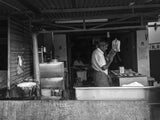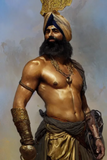Not many people really know the fact that Hindus, Muslims and Sikhs were all part of the spate of protests in Amritsar and other cities of the unified Punjab that ultimately resulted in the massacre.
The manipulators who talk disruptively today have no words for approaching common peace. They cannot, thus really comprehend how the three major communities of the undivided Punjab could act in unison, like a single body, to take on the might of British occupation forces.
The protests across the country, particularly in Punjab that encompassed present day Punjab, Pakistani province of Punjab, Haryana and Himachal Pradesh, were originally caused by the passage of the Rowlatt Act in 1919. The draconian act, passed to limit civil liberties of the general masses in the country, caused large scale protests throughout the country. The protests were particularly severe across Punjab.
General Reginald Dyer, the man who is also known as the butcher of Amritsar, oversaw the massacre involving the death of hundreds of people. General Dyer himself accepted, a few years after the dance of death, that the mob on the day would have been dispersed without firing a single bullet, but he resorted to firing as "they would have come back and laughed”. Without any sign of remorse, he went on to add that had he got hold of machine gun, he would have used that on the unarmed protesters.

Credit: Indian Express
What caused the unrest?
Saifuddin Kichlew, renowned freedom fighter and the state president of the Indian National Congress, who was also a renowned lawyer, was arrested along with another freedom fighter, Satyapal, a Congress leader and an affable homeopathic doctor. Following the arrest of the top freedom fighters from the province, large scale protests broke out throughout the state on 10 April 1919. Then on 13 April 1919, colonial forces, resorting to unwarranted show of power, opened fire at the peaceful protesters, killing many and setting a series of violent events.
In the times that we live, the thought of communal amity and the fact that all the communities acted together, fought valiantly and defeated the colonial rulers together seems to be something that could only be dreamt. But apparently, the nation, despite suffering many upheavals, is testimony to the sacrifices made by Sikhs, Hindus and Muslims together. That sort of division, on the basis of religion and caste was unheard of those days.
Victims belonged to all communities
If you analyze the name of those people who lost their lives in one of the worst massacres in the country, you will realize they belonged to all the communities. There are dozens of Muslim victims along with Hindus and Sikhs who lost their lives protesting against the arrest of a Muslim leader of the freedom movement. It should be kept in mind that Dr Kitchlew spent as many as 17 years in different jails, more than even Mahatma Gandhi or Pt. Jawaharlal Nehru.
In his book, Freedom Fighter, FZ Kitchlew says, “It was decided that a public meeting should be arranged, the purpose of the meeting being two fold, primarily to protest against the arrest of their leader Dr Kitchlew, and secondly to cool down public sentiments and restore peace in the city. A public park in the heart of Amritsar known as Jallianwala Bagh was chosen as the venue of this historic meeting. Jallianwala Bagh is enclosed on three sides by high walls which form the boundaries of adjoining houses. The only exit is wide enough to allow but a few persons to pass at a time. The meeting was scheduled for the 13th April but the same day the government enforced a curfew in Amritsar. In view of the situation some nationalist workers suggested that the meeting be postponed but Lala Hans Raj Malhotra, who was then the secretary of the local Congress Committee insisted that the meeting must be held, as people from nearby towns had already started gathering in huge numbers at the Bagh. People from all walks of life came, some on foot, some on donkey carts and some in their horse carriages”.
He goes on to add, “The atmosphere on that April morning was festive. Hindus, Muslims and Sikhs were all together showing mutual affection and unity. Young children played around while their parents chatted and sang and waited to the meeting to proceed. Little did they know that this beautiful day would turn into horror- a tragedy that will never be forgotten. An estimated 30,000 people gathered in the Bagh. A huge photograph of Dr Kitchlew was placed on the empty chair. The massive crowd was continuously shouting 'Kitchlew ko Raha Karo (Release Kitchlew). Suddenly there appeared at the entrance 150 soldiers under the command of the British General Dyre, and without giving any notice to the crowd to disperse the military blocked the only exit. Within three minutes an order was given to fire at point blank range on the armed massed”.

Credit: Tribune India
While the exact figure of the people who lost their lives unknown, as the government didn’t show much of an interest in gathering details about the massacre or the casualty figures, The Sewa Samiti society that probed the unwarranted killings later said that as many as 379 people lost their lives. Later, the Hunter Commission too said that the death figure was close to this number and the number of the injured was at least three times the number of dead. The massacre didn’t even spare small children and kids. An investigation report, to its horror, found that at least 42 young boys were among the dead, the youngest being merely 7 months old.
Going through the names of those people who sacrificed their lives for the sake of the nation is nothing less than an eye opener. From Kathri to Kaisth, from Kashmiris to Brahmins, from Muslims to Sikhs, Hindus and from toddlers to teenagers, all sacrificed their lives for the sake of the nation. Now when there is a concerted effort to brand the community anti-national, it is prudent to tell it clearly that they were not just part of the independence movement, but played a stellar role in the freedom of the nation. Dr Saifuddin Kitchlew, was heartbroken when the British divided the country. Dejected, he left Amritsar, settled in Delhi and removed himself from public life. Government Act made Dr Saifuddin Kitchlew, Jawaharlal Nehru, and Maulana Abul Kalam Azad, life trustees of the Jallianwala Bagh National Memorial Trust.

Credit: SBS Punjabi
Source :SIFY
Author :Syed Ubaidur Rahman






